Specifications
I have had discussions, sometimes heated discussions, albeit only with North
Americans, regarding the "quality of the road" or rather, according to them, "the
lack thereof" and this has in the past created issues and bad feelings. The purpose
of this new page added in January 2011 is to clarify what the property roads
are and what they are not.
First of all it is important to keep things in perspective.
Ecuadorian perspective
I observed that for westerners roads seem to be something always on their minds
whereas Ecuadorians seem to go along with whatever is available and don't even talk
about it. People coming from the first world have been living in countries where
roads are so good without ever having had to lift a finger. The roads seem to fix
themselves faster than they degrade to a point that you'd believe that they don't
need maintenance. But they do. In fact, the countries devote an extravagant proportion
of their resources in making high quality roads and repairing them all the time
before they show any defects. Not so in Ecuador.
I know for a fact that what is called a "good road" in the first world has little
to do with what is called the same here in Ecuador. I have lived 15 years in New
Zealand. I just went back last year to visit family and took a trip down from Auckland
to Nelson in a rented car. You know what my main problem was? I was constantly looking
for the potholes to avoid. However, in the several days of the trip, I did not manage
to find a single one that I could have avoided. For 100s and 100s of kilometers,
the road was so smooth, the gullies on each side so well constructed, the road marking
so perfect, that the main problem, and I believe one of the causes of many accidents,
is that you just get bored and either fall asleep or end up in some sort of a semi
hypnotized coma. Here in Ecuador, there is no risk for that. Every meter, every
curve has the potential to hide something lethal like a pile of sand covering half
the road, a big rock, a hole that will make your head hit the roof and your engine
hit the bonnet, a donkey/cow/horse/you name it or even at night a drunk old man
walking right in the middle while the truck coming the other way blinds you with
his high beams that he cannot be bothered turning off.
What I describe above are the main sealed roads such as the road between Vilcabamba
and Loja. Some roads are better such as the brand new road between Loja and Cuenca
or between Cuenca and Guayaquil, made with concrete instead of asphalt. Here I am
with my jeep somewhere along the way:
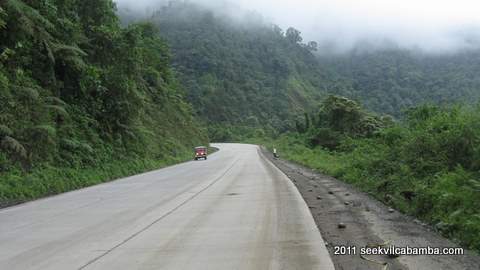
Somewhere between Guayaquil and Cuenca
On the other hand, the unsealed country roads can be really bad. The main problem
with unsealed roads is the damage caused by rain. You see, they don't build gullies
on the side of the roads. They leave it to the rain to decide where it wants to
go and usually that means somewhere in the middle where it carves channels that
only get deeper with time until the road is unpassable. The steeper the road the
worse the erosion caused by rain water will be, due to the increased velocity:
erosion damage = water quantity * water velocity
as simple as that.

Middle of the road erosion on road that lacks proper rain water management
The property roads
The roads inside the property are mostly on the steep side of the spectrum, steeper than
the 1 in 5 gradient allowed in a country like New Zealand. For those not familiar
with this measurement unit, "1 in 5" means that for each 5 meters of traveled distance
going uphill on the road, the gained elevation would be 1 meter. A one kilometer
long road with this gradient would take you up by 200 meters. The road to Loja would
more likely be 1 in 6 at most to make it suitable for buses and big trucks. The
main road is 1 in 4 and in some parts even a little steeper. I have
seen much much steeper around here. I must say that the property road feels OK
to me. I get up with the jeep in any weather without the 4x4. Also, the taxis
get up fine (they are pickups) and the small trucks get up as well. No Ecuadorian
has ever complained to me. For them it is a very good road. One just need to go
slow, pay attention in the curves and, as they say here, "no pasa nada" ("no trouble").
At least, we do have a road, most of our neighbors go on foot or with horses and
donkeys. This is a way of life in Ecuador.
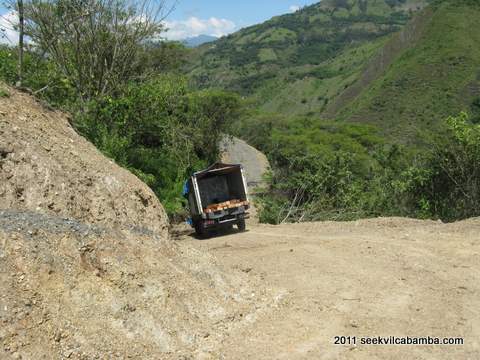
Small truck bringing building supplies to our house
Even when the road is not steep or even completely flat (some significant segments
are totally flat) the nature of the property means that they are cut perpendicular
to a steep hill. As such, on these roads, there would be a several meter high bank
on one side and a steep fall on the other side. Welcome to the Andes! We have been
once to Peru from Loja and the view from the bus down the precipice only a meter
or two from the wheel can be quite impressive!
The steeper the mountain and the wider the road, the higher (and the most potentially
unstable) the banks will be. There is no two ways about this. From day one, our
approach has been to keep the roads to the minimum width in order
to respect the mountain and cause less damage and require
less maintenance. The concept of "minimum width" is of course subjective and I suspect
that this is where differences of perceptions and opinions have led to differences
of expectations leading to discussions and conflicts.
To resolve this and spell things out, let us compare with other roads in the area.
The public road that goes down from Sacapo to the river and then along the river to the entrance
of the property is no wider than 2.7 - 3 m. It is suitable for one single vehicle.
The road has a few wider spots along the way allowing vehicles coming in opposite
directions to cross each other. All vehicles coming to our property have to go down
that road. Our roads are similar with a width between 2.5 and 3 meter,
a bit more inside the curves. Along the way they are many wider places for vehicles
to cross each other when coming in opposite directions. The roads are suitable for
one single vehicle of type jeep, pickup or small truck (called
"dyna" here) but not for dump trucks (called "volquetas"). Actually
we prohibit the use of these dump trucks because, although they
no doubt can get through the entrance bridge and theoretically could also get up
the mountain, they will cause damage to the gullies and to the curves. Also there
is no suitable place for them to turn around.
One of our owners who joined us recently and was particularly keen to use dump trucks to bring larger quantities of building material in fewer trips to his building site asked why, if we do not allow heavy trucks, is the bridge suitable for heavy trucks? The answer is simple. It did not cost that much more to build a good bridge than a bad one. Building the bridge to higher than necessary specs means that it will last. Everyone will depend on it for many many years to come as there is no alternative entrance. Therefore we did not want to compromise on that investment and we built the best possible bridge with the best team of engineers in Loja.
So, how are the property's roads built? First, a bit of background.
Background
I am a civil engineer from the university of Brussels, my city of birth. I also
speak pretty good Spanish now although I did not know a single word when I arrived
in late 2008. I liaise easily and efficiently with the local resources, municipality,
engineers, machine operators and workers. It took some time to understand how things
are done in this country because it is so different from where I was in charge of
similar work before in New Zealand. Over there, a machine operator would typically
be a man of experience, owner of his own machine. He would know how to build a road properly and he would advise
you upfront about where culverts are necessary and what gradient can be achieved
etc... Here I had to try 3 different operators working for someone else, not owning
the machine, one of them very young, the machines being old and limited in what
they can do (for example no tilting bucket to cut at angles). They really did not know how to make a road. They would cut the bank vertically instead of on an
angle, they would build the road completely flat instead of allowing a small angle
for the water to flow on one side, they would cut a deep gully on the side making
the road dangerous or they would build no gully at all. I was even told later that this is intentional
so that they give themselves work forever since every time it rains the road gets
damaged and they have to come back! It is only 6 months ago that I finally met a man who knows how to build
a road. He cuts the bank at a nice smooth angle so it will never collapse in the
future, he gives the road an angle of a few degrees forcing the water to go towards
one side (not in the middle) and he does not cut any deep gullies on the side. He can cut smooth and ample curves which is a lot more difficult than it seems. He also works
fast and the hours he charges are correct. He charges the same hourly rate as all the others. Below we see him in action cutting this small
angle with the big front bucket in order to force the water towards the bank without
the need for a deep gully, only a very shallow gully is required.
This also makes the road safer as there is no risk to "fall in the ditch" with one
wheel of the car.
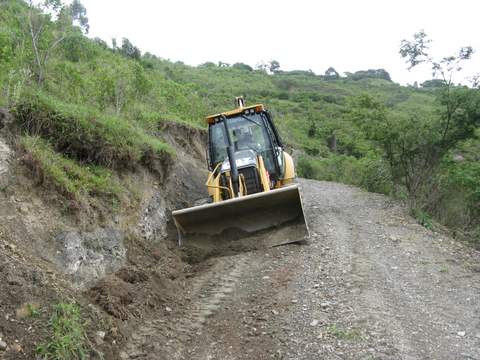
Making the road angle and cutting the shallow gullies
His name is Guido Macas from a well known and reputable family having worked for
Brian O'Leary (Montesuenos retreat center) for many years. With him I then undertook fixing his predecessors' lousy work and finishing what had to be done. Six months later, none of Guido's work has moved an inch, none of the banks that he has cut has collapsed, only the expected maintenance is needed. Unfortunately Guido was offered a large contract in another province and he left Vilcabamba.
Very recently though, you may say that serendipity hit again, I came across another operator who works the same way as Guido. He did the
final work on the road to Q14. On the photo below the angle to the left is clearly
visible. There is no deep gully but there is no need for one as the rain will have
nowhere else to go than towards the bank (left of the picture) then down (away
from the camera).
 Walking down a perfectly built segment of road
Walking down a perfectly built segment of road
Rain water management
We did pay a lot of attention to the management
of rainwater as this is the number one issue with unsealed roads. The road has suitable
rain catchment on the side all along (that small angle that is described above)
as well as numerous culverts.
Below we see a photo of a finished segment of road with surface material (called
"lastre" in Spanish)
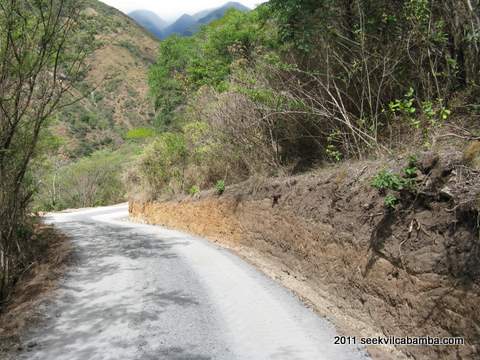
The key factor is to reduce the quantity of water that flows down in the gullies.
If we allow too much water to accumulate over a large distance it will destroy the
gully. Therefore we need to place culverts and place them at a reasonable distance
from one another.
There are different ways to build culverts and each one has its pros and cons. We
tried to use plastic pipes initially but found out that they tend to fill up rapidly
with sediments and what do you do to unblock a 6 meter long plastic pipe full of
dirt when it is buried under the road?
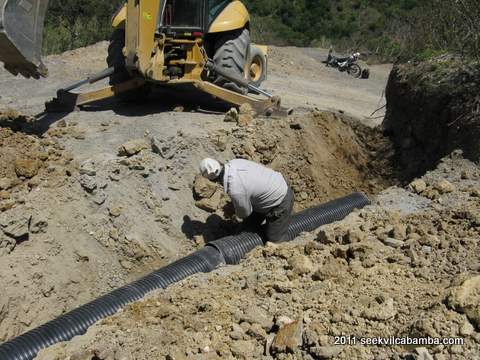
Plastic pipe culvert
So, we had to remove them and replace them with a combination of 2 other culvert
types: the concrete open channel type with two strips of reinforced concrete for
the cars to pass or the diagonal "Ford" type.

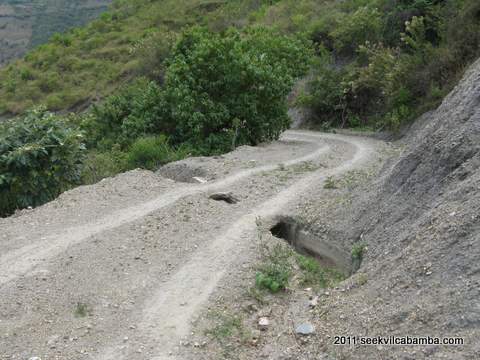
Open concrete type with strips

Ford type stabilized with river stones and cement
Note that the Ford type is positioned diagonally across the road. This is to minimize
the discomfort when passing with a car. I noticed that hardly anything at all is
felt this way. If the Ford was perpendicular to the road it you would feel it much
more.
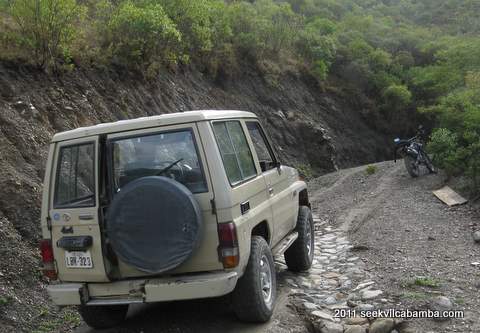
Passing the Ford with no discomfort
Both types seem to work well so far.
To reduce the amount of water flowing down the gullies we also use each curve to
our advantage because curves are ideal places to get rid of the water without the
need for a culvert. Of course what you do depends on the curve. In some curves it
is not wise to dump the water because it would just go down the next segment of
road below and cause problems over there.
All in all, building a road is a balancing act, which requires trialing approach,
observation of the natural conditions in rainy conditions, as well as patience and
humility. The water will always tell you where it wants to go and in some cases,
fighting it is not the right thing to do. Instead you have to allow it to cause erosion
somewhere.
We strongly believe that the property road is of good quality, far superior to most unsealed roads in the area. To keep it in good conditions, it will be important to maintain it and that is what we will talk about on the next page. Read on.